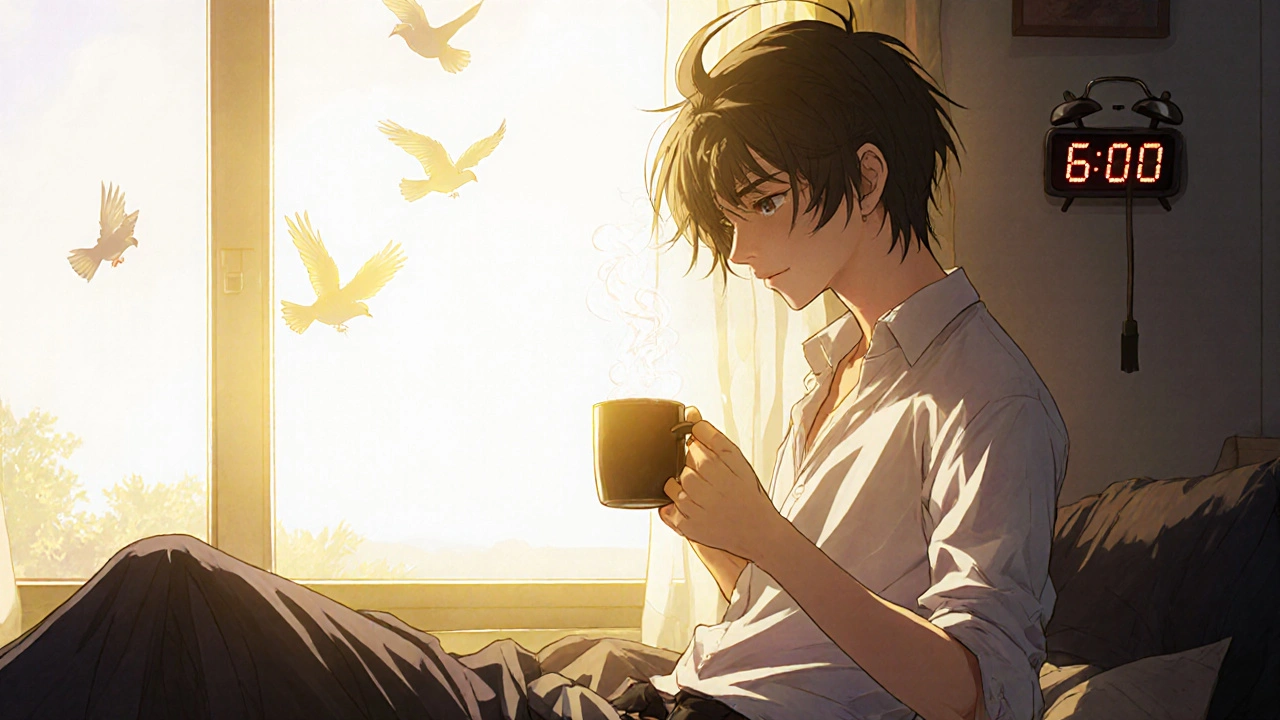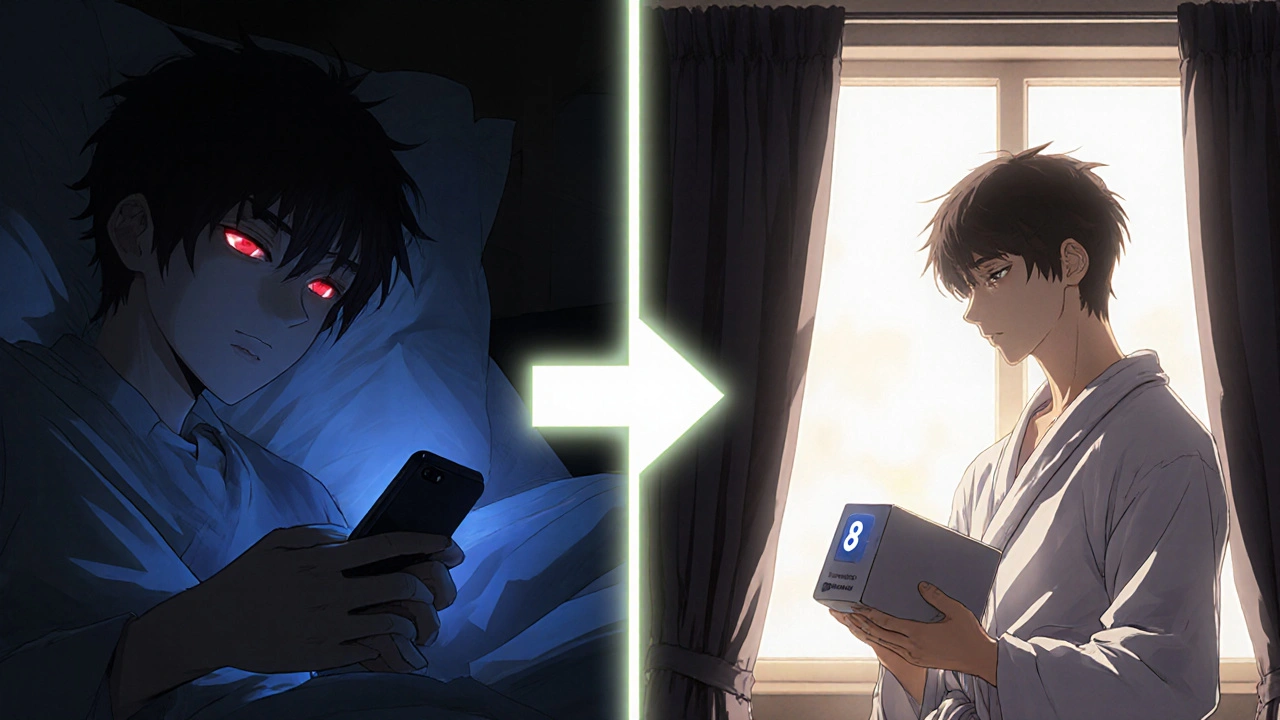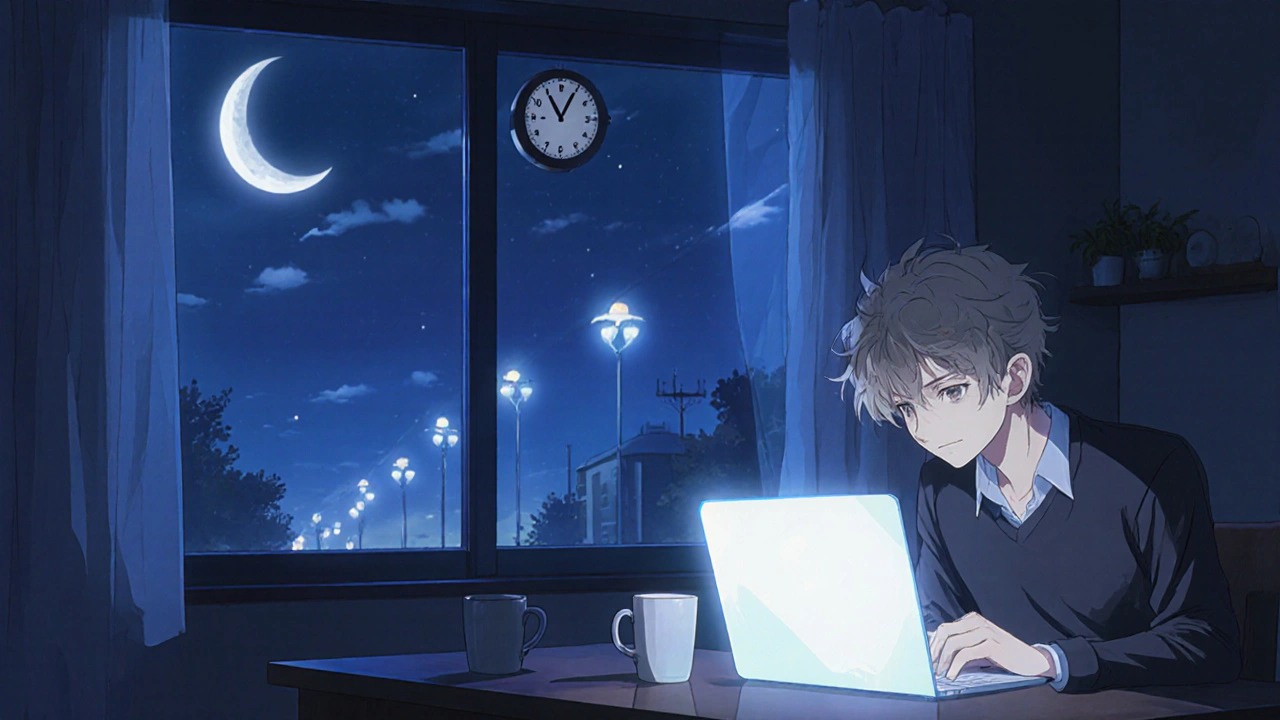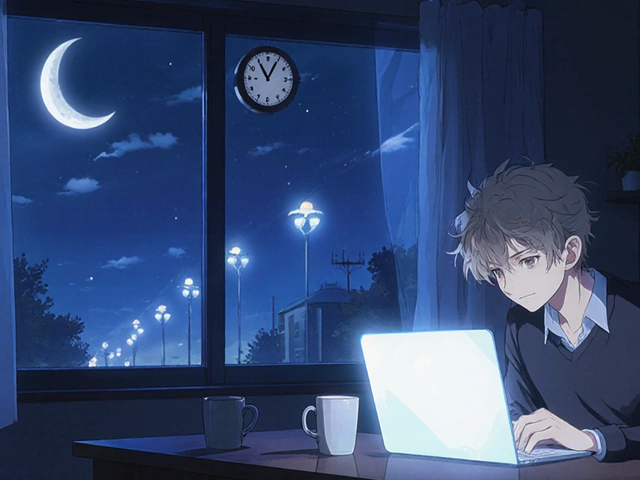Most people think being a morning person or a night person is just a preference. But it’s not. It’s biology. Your chronotype is your body’s natural rhythm - when you’re wired to wake up, when you hit your peak focus, and when you crash. Forcing yourself to wake at 6 a.m. if you’re a night owl doesn’t build discipline. It just drains you. And the same goes for staying up until 2 a.m. if you’re a morning lark. The real problem isn’t laziness. It’s mismatched schedules.
What Your Chronotype Really Means
Your chronotype isn’t about how much sleep you get. It’s about when you get it. Scientists measure it by your sleep midpoint - the halfway point between when you fall asleep and when you wake up on free days, with no alarms. If your midpoint is around 3 a.m., you’re a night owl. If it’s closer to 1 a.m., you’re likely a morning lark. About 40% of people fall into the lark category, 30% are owls, and the rest are somewhere in between.
This isn’t just about feeling groggy. Your chronotype affects your body’s core temperature, hormone release, and even how your brain processes information. A 2023 study from Imperial College London found that among older adults, night owls actually scored higher on cognitive tests than morning types. That flips the old idea that early risers are smarter. The truth? Chronotype and performance are tied to age. What works for a 20-year-old owl doesn’t work the same for a 60-year-old one.
The Hidden Costs of Being a Night Owl in a Morning World
If you’re a night owl stuck in a 9-to-5 job, you’re not just tired. You’re at risk. A 2018 study of over 430,000 people showed evening chronotypes had a higher chance of dying during the study period. Why? Because your body is constantly fighting the clock. You’re forced to wake up when your melatonin is still high. You eat dinner late, then try to sleep before your body is ready. This mismatch - called social jet lag - is real. It’s not just feeling off on Monday mornings. It’s chronic stress on your metabolism.
Night owls are 27% more likely to be obese. 30% more likely to develop type 2 diabetes. 25% more likely to have metabolic syndrome. And 29% more likely to struggle with depression. These aren’t guesses. These are numbers from BrainFacts.org’s analysis of large-scale health data. The reason? Your body’s internal clock controls insulin sensitivity, appetite hormones, and inflammation. When you’re out of sync, your body doesn’t function right.
College students who are night owls but have early classes average just 6.2 hours of sleep - compared to 7.5 hours for morning types. They nap more. They drink caffeine later in the day - often after 4 p.m. - and scroll social media in bed for an extra 40 minutes. Their grades suffer. Their mood tanks. And it’s not because they’re unmotivated. It’s because their biology is at war with their schedule.
Why Morning Larks Aren’t Always Better Off
People praise early risers. They say they’re more productive, disciplined, healthy. But the data tells a more complex story. Morning larks do get about 48 more minutes of sleep on average than night owls. They have more consistent sleep rhythms. And they’re 40% more likely to wake up feeling rested. But they’re also more likely to be women - 75% of larks in one major sleep study were female. That raises a question: Is it biology? Or is it social pressure?
Many larks wake up early not because they want to, but because they have to - kids, caregiving, early work shifts. They may feel rested, but they’re not necessarily thriving. They’re just surviving. And their productivity peaks early, which means their afternoons can drag. If you’re a lark stuck in a job that requires late meetings or evening calls, you’re just as out of sync - just in a different way.

How Your Environment Shapes Your Chronotype
Here’s the surprising part: your chronotype isn’t fixed. It can change. A 2013 study from the University of Colorado Boulder put people in a cabin in the mountains with no artificial light. After just one week, the differences between owls and larks nearly vanished. Their sleep schedules synced with sunrise and sunset. That’s powerful. It means light - especially morning light - is a major reset button for your body clock.
But modern life is working against us. A 2012 analysis showed the average person’s sleep time has shifted later by 15 minutes over nine years. Why? Screens. LED lights. Indoor living. We’re drowning in blue light at night and starving for sunlight in the morning. That’s why so many Gen Z workers - 52% - identify as night owls, compared to only 31% of Baby Boomers. We’re not lazy. We’re responding to our environment.
How to Adjust Your Schedule Without Going Crazy
You can’t change your genes. But you can change your habits. And small changes make a big difference. Here’s what actually works, based on real studies:
- Get bright light within 30 minutes of waking. Even on cloudy days, sit by a window for 30 minutes. Natural light is best, but a 10,000-lux light box works too. This tells your brain it’s daytime - and helps shift your rhythm earlier if you’re an owl.
- Keep your bedroom pitch black at night. No nightlights. No phone glow. Even 5 lux of light can mess with melatonin. Use blackout curtains. Cover LED lights on chargers.
- Cut off caffeine by 2 p.m. if you’re a lark, or 4 p.m. if you’re an owl. Caffeine stays in your system for 6-8 hours. Drinking it at 6 p.m. means you’re still half-awake at midnight.
- Stop scrolling in bed. Social media isn’t relaxing. It’s stimulating. Baylor University found night owl students used their phones in bed for 40 extra minutes - and lost nearly 45 minutes of sleep because of it.
- Wake up at the same time every day - even on weekends. This is the single most powerful habit. Consistency trains your body. It doesn’t matter if you’re an owl or a lark. If you wake at 8 a.m. Monday through Sunday, your body will adapt.
People who follow these steps for 2-4 weeks see measurable changes. SleepWatch data shows 68% of users who did at least three of these things shifted their chronotype within a month. That’s not magic. That’s biology responding to cues.

Workplaces Are Starting to Catch Up
For decades, 9-to-5 was the only option. Now, companies are realizing it’s bad for business. A 2023 Gartner survey found 42% of global organizations now offer flexible scheduling based on chronotype - up from 28% in 2020. Remote work made it easier. If you’re not in an office, why force everyone to start at the same time?
Companies that let employees choose their core hours see up to 18% higher productivity. And the market for chronotype-friendly tools is growing fast - projected to hit $1.2 billion by 2028. Startups like ChronoHealth are building algorithms that suggest optimal work hours based on your sleep data. Some employers are even testing “no-meeting Wednesdays” or letting night owls start at 10 a.m. and work until 7 p.m.
But here’s the catch: 78% of evening chronotypes in healthcare, manufacturing, and transportation still have no flexibility. They’re stuck. And that’s where the real cost lies - not just in health, but in lost productivity. The RAND Corporation estimates misaligned schedules cost the U.S. economy $411 billion a year. That’s not just about sleep. It’s about focus, mistakes, burnout, and turnover.
What You Can Do Right Now
Start by figuring out your sleep midpoint. Track your sleep for a week - no alarms, just natural wake-up times on weekends. Add your bedtime and wake time, then find the middle. If it’s before 2 a.m., you’re likely a lark. If it’s after 4 a.m., you’re an owl. If it’s in between, you’re intermediate.
Then, ask yourself: Does your schedule match your biology? If you’re an owl stuck in early meetings, you’re losing hours of peak performance. If you’re a lark stuck in late shifts, you’re burning out. The solution isn’t to become someone else. It’s to design your day around who you are.
Some jobs won’t change. But many can. Talk to your manager. Propose a flexible start time. Use your peak hours for deep work. Protect your sleep like your job depends on it - because it does.
There’s no such thing as being lazy or unmotivated because you’re not a morning person. There’s only a system that hasn’t caught up to human biology. The sooner you understand your chronotype - and the sooner workplaces do too - the better everyone will sleep, think, and live.
Can you change your chronotype?
Yes, but it takes consistent effort. Your chronotype is partly genetic, but it’s also shaped by light exposure, meal timing, and sleep habits. Studies show people can shift their sleep midpoint by 1-2 hours over 2-4 weeks by following routines like morning light exposure, avoiding screens before bed, and waking at the same time every day. It’s not instant, but it’s possible.
Are night owls less intelligent?
No. A 2023 study from Imperial College London found that among older adults, night owls performed better on cognitive tests than morning types. Earlier studies on younger people suggested the opposite, but that’s likely because schools and workplaces are designed for larks. When owls are forced into early schedules, their performance drops - not because of ability, but because of timing.
Why do I feel tired even after 8 hours of sleep?
You might be sleeping enough, but not at the right time. If your body’s natural rhythm says you should be sleeping from 1 a.m. to 9 a.m., but you’re forcing yourself into an 11 p.m. to 7 a.m. schedule, your sleep quality suffers. You’re getting hours, but not the deep, restorative sleep your body needs. That’s social jet lag.
Is it better to be a morning lark or a night owl?
Neither is better - it’s about alignment. Morning larks thrive in traditional 9-to-5 jobs. Night owls often perform better in flexible, creative, or remote roles. The health risks come from mismatched schedules, not chronotype itself. The goal isn’t to become a lark if you’re an owl. It’s to find a schedule that lets you work with your biology, not against it.
How does caffeine affect my chronotype?
Caffeine delays your body’s natural sleep signal. If you’re a night owl, drinking coffee at 6 p.m. might keep you up until 2 a.m. If you’re a lark, it might disrupt your evening wind-down. The best cutoff time? For larks, 2 p.m. For owls, 4 p.m. But everyone’s different. Track how you feel after afternoon caffeine - if you’re still alert at 10 p.m., it’s too late.






Aaron Whong
November 26, 2025 AT 23:21The chronotype paradigm fundamentally challenges the Cartesian dichotomy between willpower and biological determinism. We've been operating under a Foucauldian regime of temporal discipline-9-to-5 as a panopticon of productivity-where circadian nonconformity is pathologized as moral failure. The real epistemic violence isn't sleep deprivation; it's the institutional erasure of polyphasic human temporality in favor of monolithic industrial timekeeping. Your melatonin rhythm isn't a preference-it's an ontological signature.
When we reduce chronotype to a behavioral hack (light boxes, caffeine cutoffs), we commodify biology into a neoliberal self-optimization project. The solution isn't individual adjustment-it's systemic reconfiguration. Work hours must become circadian pluralism, not just flexible scheduling. The $411 billion loss? That's the price of ontological hegemony.
Sanjay Menon
November 27, 2025 AT 23:12Oh please. I’ve read this exact article in three different ‘biohacking’ newsletters. Everyone’s so obsessed with ‘aligning’ with their ‘natural rhythm’-as if the universe owes them a 10 a.m. start time because they’re ‘an owl.’ Newsflash: the world doesn’t revolve around your melatonin levels. You want to sleep till noon? Fine. But don’t act like your ‘biological imperative’ excuses you from showing up when the rest of the world is functional.
And don’t get me started on the ‘night owls are smarter’ narrative. That’s just woke science theater. I’ve met too many 3 a.m. scroll addicts who think their ADHD is a ‘chronotype.’ It’s not. It’s laziness with a PhD.
Cynthia Springer
November 28, 2025 AT 00:54I’m genuinely curious-how do you define ‘peak focus’ for someone who’s not a lark or an owl? The study mentions intermediate types, but there’s almost no data on them. I fall somewhere between 2:30–3:30 a.m. sleep midpoint, but I’ve never seen a study that accounts for people like me. Do we just… adapt? Or are we the outliers who get screwed by both systems?
Also, the part about women being more likely to be larks-was that controlling for caregiving roles? Because I’m a lark, but I’m not a morning person by choice. I wake up at 5:30 a.m. because my kid does. I don’t feel ‘rested.’ I feel like I’m running on fumes. So… is this biology? Or just social expectation dressed up as science?
Brittany Medley
November 29, 2025 AT 04:37Thank you for this. So many people think chronotype is about ‘willpower’-but no, it’s physiology. I’ve been a night owl since I was 12, and forcing myself into 8 a.m. meetings for 15 years gave me chronic migraines, IBS, and depression. I switched to a remote job with 10 a.m. start time. My cortisol levels normalized. My skin cleared up. My brain stopped feeling like it was wrapped in cotton.
Don’t listen to the ‘just wake up earlier’ people. They’ve never lived in your body. The light exposure tip? 100% true. I started sitting by the window for 20 minutes after waking-even on cloudy days-and my sleep midpoint shifted 45 minutes earlier in 3 weeks. No magic. Just biology responding to cues.
Also: blackout curtains. Seriously. Get them. Even a tiny LED from your charger can mess with melatonin. I covered mine with electrical tape. Game changer.
Marissa Coratti
November 29, 2025 AT 19:32As a clinical sleep researcher with over a decade of experience in chronobiology, I must emphasize that the notion of ‘changing your chronotype’ is often oversimplified in popular discourse. While circadian entrainment is demonstrably possible through photic and non-photic zeitgebers-particularly timed light exposure, consistent sleep-wake cycles, and meal timing-it is critical to recognize that genetic predisposition (PER3, CLOCK gene variants) establishes a strong baseline. The 1–2 hour shift observed in studies is statistically significant but biologically modest.
Furthermore, the correlation between chronotype and cognitive performance is not linear; it is U-shaped in adolescents and inverted-U in older adults. The Imperial College London findings must be contextualized within age-dependent neuroendocrine shifts. Night owls in their 20s may outperform larks on executive function tasks, but by age 60, the reverse is often true due to declining melatonin amplitude.
Thus, the goal should not be to ‘become’ a lark or owl, but to achieve chronotype-schedule congruence. This requires not only individual behavioral modification but also institutional redesign. The $411 billion economic loss cited is not merely a productivity metric-it is a public health crisis.
Rachel Whip
November 30, 2025 AT 13:54Just wanted to say-I’m a night owl, work in customer service, and I’ve been stuck with 7 a.m. shifts for 7 years. I used to hate my job. Then I started using blue light blockers after 7 p.m., got blackout curtains, and stopped scrolling after 11 p.m. I still wake up at 5:30 a.m., but now I’m not exhausted. I’m just… tired. Big difference.
Also, caffeine at 4 p.m. is fine for me. I’ve tested it. I sleep fine. So don’t just follow the rules-track your own body. The article’s right: it’s not one-size-fits-all.
Ezequiel adrian
November 30, 2025 AT 15:34Bro, I’m Nigerian and I work 6 a.m. to 2 p.m. because my job won’t flex. I’m a night owl. I don’t sleep until 3 a.m. I wake up at 5 a.m. I’m exhausted every day. And I still have to smile at customers. 😔
They say ‘just change your habits’-but what if your job doesn’t care about your biology? 😭
Ali Miller
December 1, 2025 AT 23:43Let’s be real: this whole ‘chronotype’ thing is just woke science nonsense designed to excuse laziness. Night owls aren’t ‘biologically disadvantaged’-they’re just addicted to their phones. The real problem? No discipline. You think your genes make you sleep late? Nah. It’s because you’d rather watch TikTok than go to bed.
And don’t get me started on ‘flex hours.’ That’s just socialism in disguise. If you can’t wake up at 8 a.m., you don’t belong in the workforce. America was built on early risers. Not people who need ‘light therapy’ to function.
Also, 52% of Gen Z are owls? That’s not biology. That’s a cultural collapse. We used to have work ethic. Now we have ‘circadian entitlement.’
JAY OKE
December 3, 2025 AT 07:08My dad’s a lark. I’m an owl. We’ve been at war over breakfast time since I was 16. He says I’m lazy. I say he’s out of touch. We finally got to a truce: he eats at 6 a.m., I eat at 10 a.m. We don’t talk about it. We just… coexist.
But honestly? The article’s right. I used to feel guilty for being up late. Now I know it’s not me-it’s the schedule. I work better at night. My brain clicks. My writing flows. I’m not lazy. I’m just wired differently.
Joe bailey
December 3, 2025 AT 16:32Love this. As a night owl who works in education, I’ve spent years apologizing for being ‘not a morning person.’ But the truth? My best lesson plans come at 11 p.m. My students notice the difference. When I finally convinced my school to let me start at 9:30 a.m., my burnout dropped by half.
And to the person saying ‘just wake up earlier’-you’ve never taught a 7 a.m. class. Trust me. It’s not willpower. It’s torture.
Also-blackout curtains. Do it. I bought mine on Amazon for £12. Changed my life. 🌙
Amanda Wong
December 4, 2025 AT 03:31Every single point in this article is dangerously misleading. The idea that chronotype is ‘biological’ and therefore immutable is a myth perpetuated by the wellness industry to sell light boxes and sleep trackers. There’s no such thing as a ‘night owl’-only people who refuse to discipline their behavior. Your body adapts. You just need to want it enough.
And that study about night owls having higher cognitive scores? It’s a correlation, not causation. They’re probably just sleep-deprived and overstimulated, not smarter. The real data shows early risers have higher GPAs, better job retention, and lower rates of substance abuse.
Stop making excuses. Wake up. Get up. Do the work. Your biology isn’t your excuse-it’s your challenge.